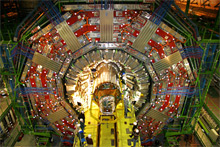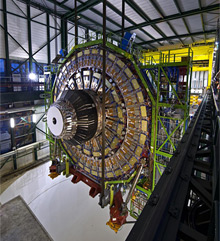Energy Frontier
CMS Detector
How it works
The Compact Muon Solenoid detector is one of two general-purpose detectors positioned along the 17-mile LHC accelerator ring.Physicists use the detector to study the array of particles and forces within the atom by recording data about collisions of protons in the machine.
One of the outstanding features of the CMS detector is its strong solenoid magnet. The solenoid is a coil of superconducting wire that creates a magnetic field when electricity flows through it. The magnetic field of the solenoid in CMS is about 100,000 times stronger than that of the Earth. The higher a charged particle’s momentum, the less its path is affected by the magnetic field. So the detector needs a strong magnet to curve the path of even particles with very high momentum.
The 12,000-ton detector is about 70 feet long, about 50 feet wide and about 50 feet high.
Beams of protons collide at the center of CMS at nearly the speed of light, creating flashes of energy that condense into particles that in turn decay into more stable particles. This volatile process replicates the conditions just after the big bang. The beams cross paths an average of 40 million times per second. When they cross, one or more pairs of protons can collide. Because mass is energy in a different form, the kinetic energy from the collision can convert briefly into massive particles heavier than the protons involved in the collision. For interesting events, the detectors record information necessary to evaluate the energy, momentum and electric charge of the emerging particles.
CMS measures particles with three layers of detectors. As particles pass through the innermost layers, made up of 15,200 highly sensitive tracking detector modules, they leave traces of energy that allow researchers to map their flight paths. Charged particles follow spiraling paths in the CMS magnetic field, and the curvature of their paths reveal their momenta.
The second layers of the detectors consist of calorimeters, which measure the energy of showers of particles by absorbing them. CMS’s calorimeter for measuring the energies of particles that interact electromagnetically, such as electrons and photons, is made up of 80,000 dense lead tungstate crystals. Its calorimeter for particles that interact via the strong force, hadrons such as protons, neutrons, pions and kaons, is made up of alternating layers that absorb particles or produce a rapid light pulse as they pass through.
The final layer of the detector is made up of muon detectors, which catch the signals of muons that pass through the calorimeters, giving up only a fraction of their energy. In total there are 1,400 muon chambers in CMS, which contains 2 million cathode strip chamber wires, each as thin as a human hair.
Questions for the Universe
Collaboration
Researchers at Fermilab participate in the collaboration for the CMS experiment as part of a team of about 3,000 scientists and engineers. CMS collaboration members come from 183 institutions in 38 countries spanning Europe, Asia, the Americas and Australasia. The collaboration for the other general purpose detector, ATLAS, includes about 1,900 scientific authors from 164 institutions in 35 countries.




